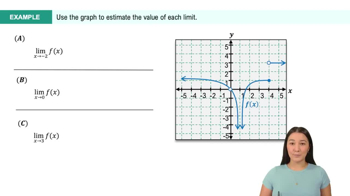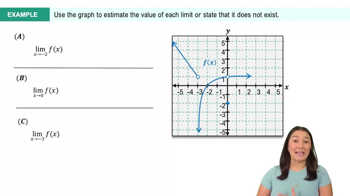Table of contents
- 0. Functions7h 52m
- Introduction to Functions16m
- Piecewise Functions10m
- Properties of Functions9m
- Common Functions1h 8m
- Transformations5m
- Combining Functions27m
- Exponent rules32m
- Exponential Functions28m
- Logarithmic Functions24m
- Properties of Logarithms34m
- Exponential & Logarithmic Equations35m
- Introduction to Trigonometric Functions38m
- Graphs of Trigonometric Functions44m
- Trigonometric Identities47m
- Inverse Trigonometric Functions48m
- 1. Limits and Continuity2h 2m
- 2. Intro to Derivatives1h 33m
- 3. Techniques of Differentiation3h 18m
- 4. Applications of Derivatives2h 38m
- 5. Graphical Applications of Derivatives6h 2m
- 6. Derivatives of Inverse, Exponential, & Logarithmic Functions2h 37m
- 7. Antiderivatives & Indefinite Integrals1h 26m
1. Limits and Continuity
Introduction to Limits
Problem 2.5.49
Textbook Question
Determine limx→∞f(x) and limx→−∞f(x) for the following functions. Then give the horizontal asymptotes of f (if any).
 Verified step by step guidance
Verified step by step guidance1
First, identify the dominant terms in the numerator and the denominator as x approaches infinity or negative infinity. For the numerator \( \sqrt[3]{x^6 + 8} \), the dominant term is \( x^2 \) because \( \sqrt[3]{x^6} = x^2 \). For the denominator \( 4x^2 + \sqrt{3x^4 + 1} \), the dominant term is \( \sqrt{3x^4} = \sqrt{3}x^2 \).
Simplify the expression by dividing both the numerator and the denominator by \( x^2 \), the highest power of x in the denominator. This gives \( \frac{x^2}{x^2} = 1 \) in the numerator and \( \frac{4x^2}{x^2} + \frac{\sqrt{3x^4}}{x^2} = 4 + \sqrt{3} \) in the denominator.
Now, evaluate the limit as \( x \to \infty \). The expression simplifies to \( \frac{1}{4 + \sqrt{3}} \). Since the terms involving \( x \) in the numerator and denominator cancel out, this is the horizontal asymptote as \( x \to \infty \).
Evaluate the limit as \( x \to -\infty \). The simplification process is similar, but consider the behavior of \( x^2 \) and \( \sqrt{3}x^2 \) as \( x \to -\infty \). The expression remains \( \frac{1}{4 + \sqrt{3}} \), indicating the same horizontal asymptote.
Conclude that the horizontal asymptote of \( f(x) \) is \( y = \frac{1}{4 + \sqrt{3}} \) for both \( x \to \infty \) and \( x \to -\infty \).
Recommended similar problem, with video answer:
 Verified Solution
Verified SolutionThis video solution was recommended by our tutors as helpful for the problem above
Video duration:
6mPlay a video:
Was this helpful?

 6:47m
6:47mWatch next
Master Finding Limits Numerically and Graphically with a bite sized video explanation from Callie
Start learning





